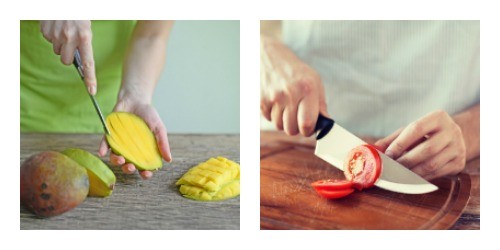Getting crafty in the kitchen can sometimes feel like a daunting task. You may think a lot of gizmos and gadgets are necessary to make a good meal. Luckily, that isn’t true. Just ask any chef and they will tell you that a SHARP knife is the single most important tool for cooking.
A sharp knife can make chopping everything – from onions to fresh herbs – easy and quick, with a little practice of course. And that can make it more enjoyable to cook your own meals and healthy cancer-protective recipes.
Finding the right knife for you will take some playing around. There are many specialized knives, but I’m focusing on the must have chef’s knife. You can use this knife to cut any ingredient you need. Follow these tips to find the perfect chef’s knife for you:
Buy your knives in person – When possible, visit a store that has a large selection of knives, such as a knife shop of a local kitchen supply store.
- Find the right size. Most people use an 8-inch or 10-inch chef’s knife, though these knives range from 6-12 inches. Because size will determine how much control you have while chopping, this is an important decision. Hold and feel the knife in your hand to determine if the size of the blade and weight of the knife make you feel comfortable. If the store allows, try moving the knife in a chopping motion on a cutting board. In most cases, if you feel comfortable with your grip and weight of the knife, cutting things should be comfortable as well. We don’t want any fingers lost!
- Find the right handle. Once you are familiar with how to properly hold a knife, the make of the knife’s handle will be an important focus. Some knife handles are long and round, some are rectangular in shape and have grooves for your fingers to fit into, while others take a more unique shape. Again, it is important that you are able to hold the knife and practice your grip.
- Think about price. What is a reasonable price-range? An average price ranges between $80-$200. There are certainly cheaper and more expensive options. Knives that fall below this range may take a little more upkeep than those higher in price. You may have to sharpen your knife more often or find that it rusts more easily depending on the type of steel it is made from.
- Do you need rust-resistant steel? Rust-resistant steels make for easier maintenance of your knife. If you are going to invest a lot of money in a knife, wash your knife by hand with warm, soapy water and completely dry it before putting away. If you do this, rust should not be a problem. If you’re an avid dishwasher user, getting a rust-resistant steel is going to be a good choice for you.
- Keep your knife sharp. In general, your knife will probably need to be sharpened your knife may need to be sharpened 3-4 times per year. (If you use honing tools to maintain the blade’s sharp edge, then sharpening 1-2 times a year is fine.) One method for sharpening your knife is a whetstone. You can always take your knife to a local sharpener and they can take care of it for you.
Take a look at the link below on how to comfortably hold a knife. Happy chopping!






